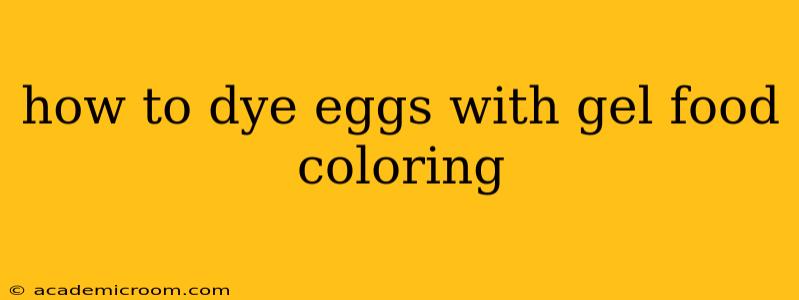Gel food coloring offers a vibrant, concentrated alternative to liquid food coloring for dyeing Easter eggs (and beyond!). Its intense pigmentation allows for richer, more saturated colors, even with less product. This guide will walk you through the process, addressing common questions and offering tips for achieving professional-looking results.
What are the benefits of using gel food coloring for dyeing eggs?
Gel food coloring boasts several advantages over its liquid counterpart. Its highly concentrated nature means you need less to achieve bold, brilliant hues. This is especially beneficial for achieving deep, jewel-toned colors or creating unique ombre effects. Additionally, gel food coloring tends to leave a more even, less streaky finish on the eggshells. Finally, its thicker consistency makes it less likely to run or bleed, simplifying the dyeing process and improving your overall results.
What supplies do I need to dye eggs with gel food coloring?
Before you begin, gather these essential supplies:
- Hard-boiled eggs: Ensure your eggs are completely cooked and cooled before dyeing.
- Gel food coloring: Choose your favorite colors! A variety of shades allows for creative mixing and layering.
- White vinegar: This helps set the color and enhances its vibrancy.
- Spoons or pipettes: For precise color application.
- Bowls or cups: One for each color you’ll be using.
- Paper towels: For clean-up and blotting excess dye.
- Gloves (optional): To prevent staining your hands.
How much gel food coloring should I use per egg?
The amount of gel food coloring needed depends on the intensity of color desired. Start with a small amount—about a teaspoon per bowl of water—and add more gradually until you reach your desired shade. Remember, it's easier to add more color than to remove it! For very deep, saturated colors, you may need to increase this amount. Experiment to find the perfect balance.
How do I dye eggs with gel food coloring?
Follow these simple steps for flawlessly dyed eggs:
- Prepare your dye baths: In separate bowls, combine warm water with a small amount of white vinegar. Add gel food coloring to each bowl, stirring until the color is evenly distributed. The intensity of the color will depend on the amount of gel food coloring you add.
- Submerge the eggs: Gently place your hard-boiled eggs into the dye baths. Ensure the eggs are fully submerged to achieve even coloring.
- Let them soak: Allow the eggs to soak for at least 15-20 minutes, or longer for deeper color saturation. The longer the eggs soak, the more intense the color will be. Regularly check the color development.
- Remove and dry: Once you've reached your desired color, carefully remove the eggs from the dye baths using a spoon and place them on a paper towel to dry.
Can I mix gel food coloring to create custom colors?
Absolutely! One of the great advantages of using gel food coloring is the ability to create custom colors by mixing different shades. Experiment with various combinations to discover unique and beautiful hues. Start with small amounts and gradually add more until you achieve the perfect blend.
How can I achieve different effects, such as ombre or marble?
Ombre: Create a gradient effect by adding varying amounts of gel food coloring to separate bowls, creating a spectrum of shades from light to dark. Dip your eggs partially into each bowl, gradually increasing the depth of immersion for a smooth, blended color transition.
Marble: Add a few drops of one color to a bowl of warm water. Then, add a different color and swirl gently. Submerge the egg and gently roll it in the dye bath to achieve a marbled appearance.
How do I make the colors last longer?
After the eggs are thoroughly dry, you can add a layer of sealant for added protection and longevity of the color. A thin layer of cooking oil will work, or a commercial egg sealant is also a good choice.
By following these steps and employing a bit of creativity, you can achieve stunningly colored eggs using gel food coloring. Happy dyeing!
